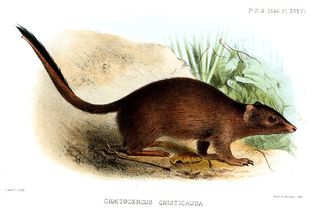
Mulgara
Order : Dasyuromorphia
Family : Dasyuridae
Species : Dasycercus cristicauda
The Mulgara is listed as Vulnerable (VU), considered to be facing a high risk of extinction in the wild, on the IUCN Red List of Threatened Species
Countries
AustraliaSome facts about the
Mulgara
Adult weight : 0.115 kg (0.253 lbs)
Maximum longevity : 7 years
Female maturity :315 days
Male maturity : 315 days
Gestation : 38 days
Weaning : 121 days
Litter size : 7
Interval between litters : 365 days
Weight at weaning : 0.022 kg (0.0484 lbs)
Body mass : 0.091 kg (0.2002 lbs)
Facts about the mulgara
The mulgara (Dasycercus cristicauda) is listed as PRESUMED EXTINCT on the schedules of the NSW Threatened Species Conservation Act.
One of the rarest marsupials in Australia the Mulgara (Dasycercus cristicauda) is known to live here as do over 180 bird species and many lizard species. (Full text)
The Mulgara Dasycercus cristicauda is a small native carnivore that inhabits the arid sandy regions of Australia. (Full text)
It is believed that the population of the mulgara is dependent on the quality of each season. (Full text)
The Mulgara is one of the most perfectly adapted desert marsupials.
The Mulgara is a carnivorous marsupial belonging to the Family Dasyuridae.
The marsupial mole has no eyes and burrows in the sand, while the mulgara is a sharp toothed insect eating animal. (Full text)
A mulgara is discovered during a fauna survey for tjakura - great desert skink (Full text)
A mulgara is a small tree of the arid regions another
The marsupial mole has no eyes and burrows in the sand, while the mulgara is a sharp toothed insect eating animal. (Full text)
The tiny mulgara is a mouse-like marsupial that hunts for insects at night. (Full text)
Mulgara is licensed to SGB Aust and has had very limited evaluation in SA.
Lifespan/Longevity Mulgaras are known to live for at least six years in the wild. (Full text)
Mulgaras are feisty little desert carnivores that eat insects, reptiles, and even other mammals.
More animals beginning with M
